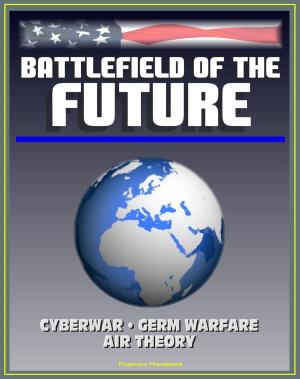21st Century U.S. Military Manuals: Mission Command - 2012 Army Doctrine Reference Publication ADRP 6-0, Land Operations, Warfighting Function Tasks (Professional Format Series)
Nonfiction, History, Military, United States| Author: | Progressive Management | ISBN: | 9781301663699 |
| Publisher: | Progressive Management | Publication: | November 30, 2012 |
| Imprint: | Smashwords Edition | Language: | English |
| Author: | Progressive Management |
| ISBN: | 9781301663699 |
| Publisher: | Progressive Management |
| Publication: | November 30, 2012 |
| Imprint: | Smashwords Edition |
| Language: | English |
Professionally converted for accurate flowing-text e-book format reproduction, Army Doctrine Reference Publication (ADRP) 6-0 augments the mission command doctrine established in Army Doctrine Publication (ADP) 6-0, also titled Mission Command. This publication contains an expanded discussion on the overarching doctrinal guidance on command, control, and the mission command warfighting function. It describes how commanders, supported by their staffs, combine the art of command and the science of control to understand situations, make decisions, direct action, and lead forces toward mission accomplishment.
Historically, military commanders have employed variations of two basic concepts of command: mission command and detailed command. While some have favored detailed command, the nature of operations and the patterns of military history point to the advantages of mission command. Mission command has been the Army's preferred style for exercising command since the 1980s. The concept traces its roots back to the German concept of Auftragstaktik, which translates roughly to mission-type tactics. Auftragstaktik held all German commissioned and noncommissioned officers dutybound to do whatever the situation required, as they personally saw it. Understanding and achieving the broader purpose of a task was the central idea behind this style of command. Commanders expected subordinates to act when opportunities arose.
Army Doctrine Reference Publication (ADRP) 6-0 develops the concept of mission command to help Army forces function effectively and accomplish missions. This publication expands on the principles of mission command found in ADP 6-0. ADRP 6-0 updates mission command doctrine to incorporate the Army's operational concept of unified land operations, found in ADP 3-0. ADRP 6-0 remains generally consistent with the doctrine in the 2011 edition of Field Manual (FM) 6-0, Mission Command, on key topics, while adopting updated terminology and concepts as necessary. These topics include mission command as a foundation of unified land operations and updated mission command warfighting function tasks.
Chapter 1 * THE EXERCISE OF MISSION COMMAND * The Nature of Military Operations * Unified Land Operations and Mission Command * The Army's Approach to Mission Command * Chapter 2 * THE MISSION COMMAND PHILOSOPHY OF COMMAND * Principles of Mission Command * Art of Command * Science of Control * Application of the Mission Command Philosophy * Chapter 3 * THE MISSION COMMAND WARFIGHTING FUNCTION * Definition and Purpose * Mission Command Warfighting Function Tasks * Mission Command System
As a bonus, this reproduction includes the complete 2012 Army Leadership manual (FM 6-22), which describes the Army's view of leadership, outlines the levels of leadership (direct, organizational, and strategic), and describes the attributes and core leader competencies across all levels.
Professionally converted for accurate flowing-text e-book format reproduction, Army Doctrine Reference Publication (ADRP) 6-0 augments the mission command doctrine established in Army Doctrine Publication (ADP) 6-0, also titled Mission Command. This publication contains an expanded discussion on the overarching doctrinal guidance on command, control, and the mission command warfighting function. It describes how commanders, supported by their staffs, combine the art of command and the science of control to understand situations, make decisions, direct action, and lead forces toward mission accomplishment.
Historically, military commanders have employed variations of two basic concepts of command: mission command and detailed command. While some have favored detailed command, the nature of operations and the patterns of military history point to the advantages of mission command. Mission command has been the Army's preferred style for exercising command since the 1980s. The concept traces its roots back to the German concept of Auftragstaktik, which translates roughly to mission-type tactics. Auftragstaktik held all German commissioned and noncommissioned officers dutybound to do whatever the situation required, as they personally saw it. Understanding and achieving the broader purpose of a task was the central idea behind this style of command. Commanders expected subordinates to act when opportunities arose.
Army Doctrine Reference Publication (ADRP) 6-0 develops the concept of mission command to help Army forces function effectively and accomplish missions. This publication expands on the principles of mission command found in ADP 6-0. ADRP 6-0 updates mission command doctrine to incorporate the Army's operational concept of unified land operations, found in ADP 3-0. ADRP 6-0 remains generally consistent with the doctrine in the 2011 edition of Field Manual (FM) 6-0, Mission Command, on key topics, while adopting updated terminology and concepts as necessary. These topics include mission command as a foundation of unified land operations and updated mission command warfighting function tasks.
Chapter 1 * THE EXERCISE OF MISSION COMMAND * The Nature of Military Operations * Unified Land Operations and Mission Command * The Army's Approach to Mission Command * Chapter 2 * THE MISSION COMMAND PHILOSOPHY OF COMMAND * Principles of Mission Command * Art of Command * Science of Control * Application of the Mission Command Philosophy * Chapter 3 * THE MISSION COMMAND WARFIGHTING FUNCTION * Definition and Purpose * Mission Command Warfighting Function Tasks * Mission Command System
As a bonus, this reproduction includes the complete 2012 Army Leadership manual (FM 6-22), which describes the Army's view of leadership, outlines the levels of leadership (direct, organizational, and strategic), and describes the attributes and core leader competencies across all levels.















